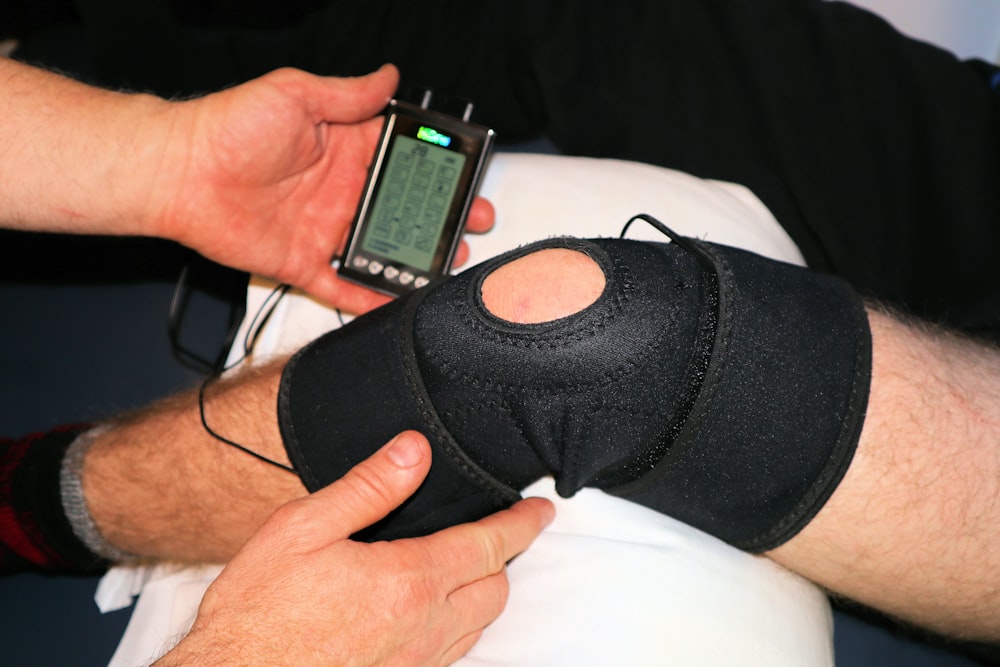目次
変形性膝関節症例の遺伝子型によってTENSの効果が異なる可能性
TENSといえば鎮痛目的に実施されることが多い物理療法集団の1つです.
変形性膝関節症例における膝関節に対してもTENSが使用されることは多いですし,過去にも多くの研究でTENSによる鎮痛効果が明らかにされております.
ただ臨床上はTENSの効果が得られる症例もいれば効果が乏しい症例っていますよね.
今回は変形性膝関節症例の遺伝子型によってTENSの効果が異なる可能性を示唆する研究論文をご紹介させていただきます.

今回ご紹介する論文
European Journal of Pain
ORIGINAL ARTICLE
Effects of genotype on TENS effectiveness in controlling knee pain in persons with mild to moderate osteoarthritis
ManikaGovil,NanditaMukhopadhyay,TeriHolwerda,KathleenSluka,BarbaraRakel,Debra L. Schutte,
First published: 29 October 2019 https://doi.org/10.1002/ejp.1497Citations: 6
今回ご紹介する論文は2019年に掲載された論文です.
研究の目的
This study examined the extent to which genetic variability modifies Transcutaneous Electrical Nerve Stimulation (TENS) effectiveness in osteoarthritic knee pain.
この研究では,変形性膝関節症例の疼痛に対する経皮的電気神経刺激(TENS)の有効性が遺伝的変異によってどの程度変化するかを明らかにすることを目的としております.
研究の方法
Seventy-five participants with knee osteoarthritis were randomly assigned to either: (a) High-frequency TENS, (b) Low-frequency TENS or (c) Transient Placebo TENS. Pain measures were collected pre- and post-treatment. Participants were genotyped on genes implicated in central or peripheral pain pathways: NGFB, NTRK1, EDNRA, EDNRB, EDN1, OPRM1, TAC1, TACR1, BDNF, BDKRB1, 5HTT, COMT, ESR2, IL6 and IL1B. Genetic association using linear regression modelling was performed separately for the transient placebo TENS subjects, and within the High-frequency TENS + Low-frequency TENS participants, including TENS level as a covariate.
変形性膝関節症例75例を以下の条件でいずれかに無作為に割り付けております.
(a)高周波TENS
(b)低周波TENS
(c)一過性プラセボTENS
疼痛の評価は治療前後で実施しております.
合わせて中枢または末梢の疼痛経路に関与するNGFB, NTRK1, EDNRA, EDNRB, EDN1, OPRM1, TAC1, TACR1, BDNF, BDKRB1, 5HTT, COMT, ESR2, IL6, IL1Bといった遺伝子の遺伝子型を調査しております.
線形回帰モデリングを用いた遺伝的関連性は,一過性のプラセボTENS群と,高周波TENS群+低周波TENS群の中で,TENSレベルを共変量として含めて検討が行われております.
研究の結果
In the placebo group, SNPs rs165599 (COMT) was significantly associated with an increased heat pain threshold (β = −1.87; p = .003) and rs6827096 (EDNRA) with an increased resting pain (β = 2.68; p = .001). Within the treatment groups, TENS effectiveness was reduced by the SNP rs6537485 (EDNRA) minor allele in relationship to mechanical sensation (β = 184.13; p = 5.5E−9). Individuals with the COMT rs4680 minor allele reported lowered pain at rest after TENS (β = −42.30; p = .001), with a higher magnitude of pain reduction (28 unit difference) in the low-frequency TENS group compared to the high-frequency TENS group (β = 28.37; p = .0004).
プラセボ群ではSNPs165599(COMT)が温熱痛覚閾値の上昇(β=-1.87;p=0.003),rs6827096(EDNRA)が安静時痛の上昇(β=2.68;p=0.001)と有意に関連しておりました.
治療群では機械的感覚に関連するSNP rs6537485(EDNRA)マイナーアリルによって,TENSの効果が減弱しました(β=184.13;p=5.5E-9).
COMT rs4680マイナーアリルを持つ症例では,TENS後の安静時の痛みが軽減され(β=-42.30;p=0.001),低周波TENS群では高周波TENS群に比べて痛みの軽減の大きさ(28単位の差)が大きい結果でありました(β=28.37;p=0.0004).
研究の結論
EDNRA and COMT are implicated in osteoarthritic knee pain and provide a basis for tailoring TENS interventions according to individual characteristics.
EDNRAとCOMTは変形性膝関節症の疼痛に関与しており,個人の特性に応じてTENSの介入方法を調整するための基盤となることが示唆されます.
研究の意義
Findings from this study demonstrate that genetic variation within the COMT and EDNRA genes influences the effectiveness of TENS, a non-pharmacologic pain-reduction intervention, in the context of osteoarthritic knee pain. Evidence such as this may contribute to risk models that provide a clinically useful tool for personalizing TENS interventions according to individual characteristics in order to best control pain and maximize functional status.
この研究ではCOMTとEDNRAの遺伝子変異が,変形性膝関節症の疼痛に対する非薬物療法であるTENSの効果に影響を与えることが明らかになりました.
今回の結果は疼痛を最適にコントロールし,機能的状態を最大限に高めるために,個人の特性に応じてTENSの介入を個別化するための臨床的に有用なツールとなる可能性がある.
これは非常に興味深い研究ですね.
こういった遺伝子レベルでリハビリ効果が見込まれる症例が明らかになれば,物理療法を行うべきクライアントが明確にできます.
遺伝子レベルでリハビリ効果が高い症例とそうでない症例が予測できるような未来が待っているのでしょうか?






